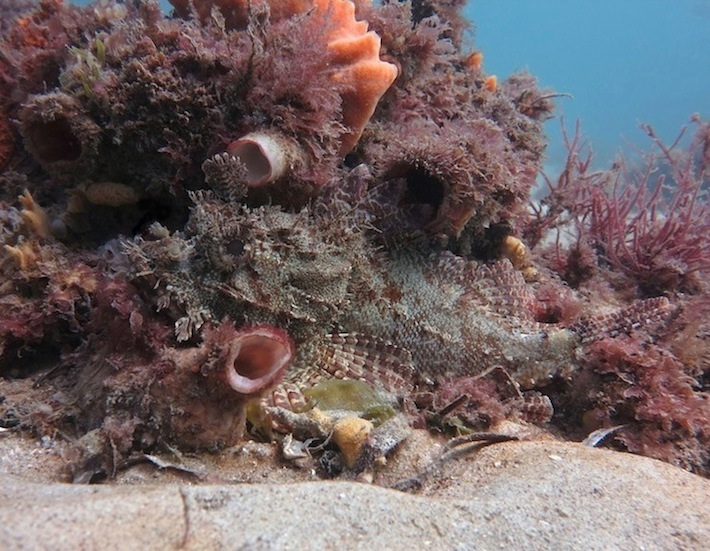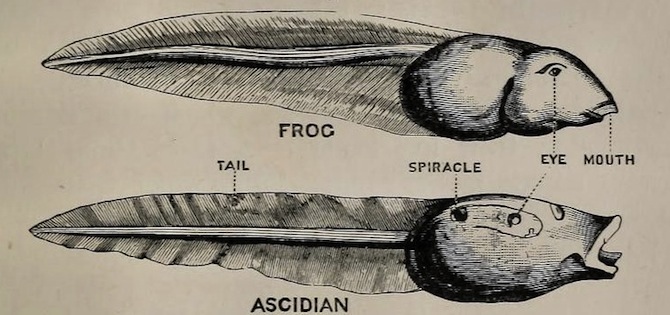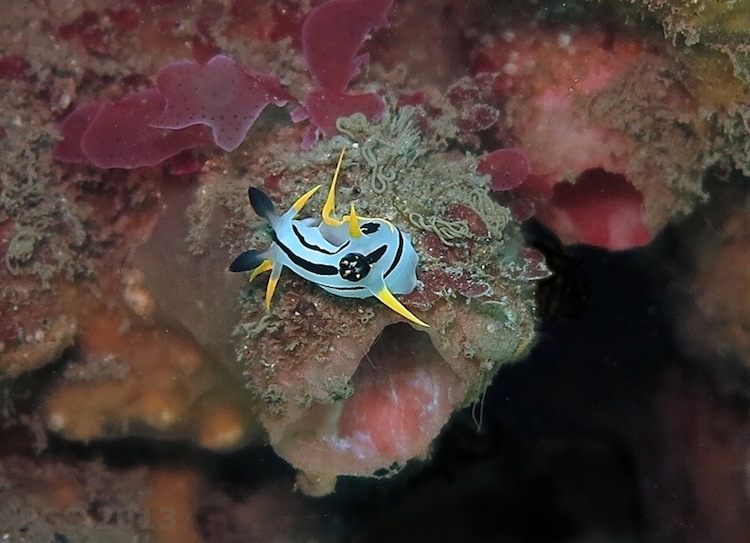35. The Tunicate Sighs
 After our trip to Octopolis last month, I went diving with David Scheel at Nelson Bay, a little way up the coast from Sydney. We went to a spot called the ‘Pipeline,’ known for its profusion of small and curious animals. Especially enchanting were the decorator crabs. These crabs festoon their bodies with bits of sponge and seaweed, encouraging these suits to continue living and growing. In time they become little walking ecologies.
After our trip to Octopolis last month, I went diving with David Scheel at Nelson Bay, a little way up the coast from Sydney. We went to a spot called the ‘Pipeline,’ known for its profusion of small and curious animals. Especially enchanting were the decorator crabs. These crabs festoon their bodies with bits of sponge and seaweed, encouraging these suits to continue living and growing. In time they become little walking ecologies.
The pale pink spout-like structures in the photo at the top are parts of animals called Tunicates – and within that group, Ascidians or sea-squirts. They are filter-feeders, permanently attached to a surface. The spout is the outflow. Most of the time they seem like plants, not animals. In fact, they are often so encrusted that they seem more like part of the physical landscape in which other things live, rather than organisms in their own right. Sponges coat them. When you are looking at a nudibranch, tunicates are often the floor or the walls.
Given their appearence, I am always startled when, occasionally, a tunicate partially collapses its shape and visibly expels whatever is inside it. This motion occurs on the familiar animal time-scale, and it looks like a sigh. The landscape comes to life and makes its own pessimistic comment on the scene. I wish I had a little video of this, but it always happens when I least expect it.
Though adult tunicates of this kind are anchored like plants, they are more closely related to us than most of the other animals discussed on this website – closer to us than cephalopods, other molluscs, and crabs. Tunicates are in the chordates, the same group that includes vertebrates like us. A relevant fragment of the tree of life looks like this:
 It’s surprising that our fairly close relatives include something so similar to a plant. The kinship was noticed long before any genetic analysis, though, because of the tunicates’ juvenile stage. Though the adult stage is plant-like, young tunicates look and swim like frog tadpoles, with a tail and a nerve cord down their back.
It’s surprising that our fairly close relatives include something so similar to a plant. The kinship was noticed long before any genetic analysis, though, because of the tunicates’ juvenile stage. Though the adult stage is plant-like, young tunicates look and swim like frog tadpoles, with a tail and a nerve cord down their back.
 The picture on the right is from 1901:†
The picture on the right is from 1901:†
The tadpoles swim, attach to a suitable surface, and change form, digesting most of their smarter parts. Only the occasional sigh remains.
When I was young I read a children’s book (whose name I can’t remember) which presented, as part of its climax, the idea that many natural processes involve agency and consciousness on different scales in space and time from the ones we are used to. Some processes of geological and ecological change, if sped up sufficiently, would appear to us to be the activities of very large living agents.
Could the world be this way? Why not? How could we know that it’s not this way – that there isn’t some scale in space and time at which some (not all) geological and ecological processes comprise a kind of thought? And if there are no such phenomena, then why do cognitive and conscious phenomena have the time-scale they have? Why aren’t some of them much slower or faster – slower, especially, as there can’t be a physical impediment to a huge slow-down, as opposed to a speeding-up?
Evolutionary theory, in combination with some ideas in the philosophy of mind, has something to say about this.
The physical processes within living systems like ourselves that give us experience and consciousness arise through evolution by natural selection. These processes arise as part of a system of that controls behavior, enabling the organism to deal with threats, take in energy, reproduce, and so on. Evolution sets the temporal scale of behavior, and sets the temporal scale of the inner processes that control it. For all this to happen on a much slower scale, there has to be an evolved system living at that scale, one whose inner processes enable it to deal with problems of control existing on that scale. There must be events to respond to, and actions to coordinate, that take millenia to occur, and where success in these activities leads to systems of that kind reproducing more than systems that cannot achieve that coordination. (Evolution by natural selection is not just a matter of “survival,” or staying around; in order for improvements to accumulate, there has to be multiplication as well.) There probably aren’t any evolving populations made up of entities living on this scale. People sometimes think that species are like this – are like organisms, in a sense – but this is probably an error. It’s possible, perhaps, for technology to change the situation here – to give rise to processes that generate living and intelligent systems on a different spatial and temporal scale. Our imaginings here are affected, though, by the operation of our own hyperactive “agency-detection” mechanisms, our tendency to see agency in activities and movements of many kinds.
____________________
Notes: The fish in the top photo looking like a character from Mervyn Peake, is – I think – an Eastern Red Scorpionfish. I don’t know the species of Ascidian in the pictures. The decorator crab is Hyastenus elatus. The nudibranch is, I think, Polycera capensis.
† From A Guide to the shell and starfish galleries of the British Museum, via Wikimedia.
Dave Harasti is a very good photographer who specializes in Nelson Bay images. Thanks also to Emma at Let’s Go Dive shop.
December 2013: A page with further comments on the philosophical side of this post is here.


